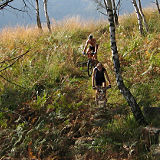hints and advices
Buyers guide
Full or front? 26 or 29 inch? Tubes o tubeless? The questions are old, but they finally found an answer... actually, more than one...
The frame: front or full?
Aside from the racing world, nowadays the fullies are preferable on most conditions. The hardtails, however, still have a major advantage: at a comparable quality level, they offer a much lower price. If you are tight on your budget, you should consider investing in a good quality hardtail rather than a medriocre fully. Another very important aspect for the riders wanting to get into extreme biking is the fact that the hardtails are usually way more suitable to be carried on the shoulder!

The wheels: 26 or 29 inch?
29ers are tanks, and they can overcome hurdles easier. 26ers are more agile and nervous, and they feels more confortable on very technical trails. Choose basing on your driving style. And if you have no clue, there are 27.5ers, which are a good compromise...
Tyres: tubes or tubeless?
Tubeless tyres are a cool invention. The only problem is that repair can be more complicated. When you are travelling in lonely and impervious regions, you might choose old tires with inner tubes.
If you have tubeless tires you should carry a spare tube than you can insert into the tire in case you won't be able to fix it.

Brakes: discs or V-brakes?
There are many arguments for one or the other type (weight, power, sensitivity, noise, cost, maintenance, wear), but the differences are not so big. V-brakes are cheaper and less complicated, but they behave well under most conditions, beside snow and deep mud... Before deciding what brakes you want to get, you should first think of where you're going to ride your bike the most. And remember it's always better to get a high quality v-brake than a low quality mechanical disc brake!
Pedals: flat or SPD?
The eternal doubt between regular and clipless pedals has found an intelligent answer: the double-sided pedals. When you go uphill you can fasten them, but when facing the most dangerous trails you can rotate them and use them like regular pedals. Another plus is that you can use them with MTB shoes as well as with mountain boots.
The only problem with double-sided pedals is that they've got two sides... you never find the right side at the first try!

The cables: above or below?
In some frames the rear brakes and derailleur cables are located under the top tube. That isn't going to upset nobody at first sight, but try to carry a bike with such a frame. Your collarbone will soon turn into a cableguide... The position of the cables is also another detail that extreme MTBikers have to consider when buying a new bicycle!













